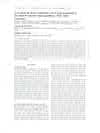A Re-Analysis of the Supposed Role of Lead in Sir John Franklin’s Last Expedition, 1845-48 (2014 January 9)
The ‘Franklin expedition’ of 1845 set out to establish a ‘northwest passage’ between the Atlantic and Pacific oceans but ended with the deaths of all 129 crewmen in the grimmest of circumstances. The hypothesis that lead poisoning may have contributed to the disaster is examined by re-analysis of the bone-lead content of seven skeletons in order to model statistically the likely variation in lead burden across the whole crew. Comparison of the estimated lead burdens with present-data that associates lead with cognitive and physical morbidity suggests that a proportion of the crew may have experienced few or no adverse effects whilst those with higher burdens may have suffered some significant debility. It is unclear whether such debility would have been incapacitating or exceptional for the lead-contaminated environment of nineteenth-century Britain. Whilst lead alone may not have caused the disaster, it is proposed that high levels of lead may have interacted with other factors including dietary insufficiencies and individual constitutional differences to render some, but not all, of the crew more vulnerable to debility in the final throes of the expedition.
General Conclusions
Considerable caution is required in drawing conclusions from the present analysis. The levels of lead, whilst high relative to those of today, are estimated to have varied widely across the crew. It is not clear that these levels, and their variability, would have been unusual in nineteenth-century Britain. The overlap of the distributions of lead burdens between present-day, lead-exposed subjects and the Franklin crew implies that at least a proportion of the men, those with lower burdens, would have been little, if at all, impaired. If the estimated range in lead burden across the crew was similar to that of the ‘on-shore’ nineteenth-century population where lead poisoning was not uncommon, then it would be logical to assume that some of the crew with high burdens may have been at risk of experiencing significant symptoms. Whether the nature and degree of those symptoms would have led to wide-scale incapacity must be considered in light of evidence that some present-day individuals may have high levels of bone and blood lead that do not appear to prevent their remaining in employment and apparently functioning ‘normally’. This conclusion is consistent with the long-known development of tolerance to chronic lead exposure and inter-individual variability in susceptibility to its adverse effects. Equally, whilst the adverse effects of lead may not have been incapacitating alone, they may have contributed to significant debility by interacting with factors such as dietary insufficiency, stress and despair.
[…]
There are a number of significant limitations to the present analysis. First, the available sample sizes are small so that only cautious estimation can be made of effects in the whole crew. Secondly, Keenleyside has noted that measured levels of lead from the same bone will vary depending upon the analytic procedure and bone site sampled: clearly such variation will affect the replication of effects and raise uncertainty as to the absolute lead burden of the crew. Thirdly, comparisons between Franklin’s men and lead-exposed, present-day groups must be tentative and illustrative, rather than definitive, as to the effects of lead on the crew. The central difficulty is that conclusions are greatly hampered by the lack of control data which would allow reliable determination of whether the levels of lead found in Franklin’s men were typical of contemporary Royal Navy crews who had been on similar missions, and of the nineteenth-century population as a whole. There would be considerable practical impediments to obtaining such control data but it would offer the means to a definitive test of the lead-poisoning hypothesis.





